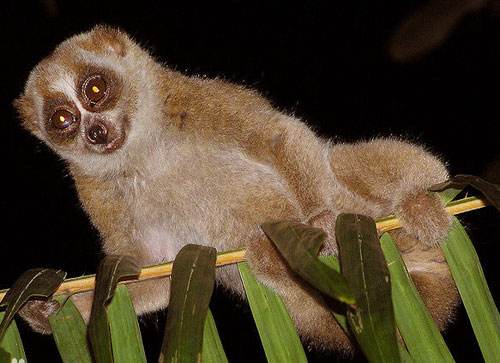Loris tardigradus
IUCN
LCBasic Information
Scientific classification
- name:Loris tardigradus
- Scientific Name:Slow loris,Bengal slow loris, gray slow loris, wind civet, flat monkey, shy cat, mimic monkey
- Outline:Primates
- Family:Primates Lorisidae Loris
Vital signs
- length:28-38cm
- Weight:1-2kg
- lifetime:15-18year
Feature
The only venomous primate on Earth
Distribution and Habitat
Origin: Bangladesh, Bhutan, Cambodia, China, India, Laos, Myanmar, Thailand and Vietnam.
Possibly present: Malaysia.
China is distributed in southern Yunnan and parts of Guangxi.
Slow lorises are nocturnal and arboreal. They prefer areas with higher canopies and forest edges, where insects are more abundant. They live year-round in tropical and subtropical rainforests and semi-evergreen rainforests in Southeast Asia. However, their habitats are increasingly being destroyed due to deforestation and land development, and they are forced to live in shrub forests. The species prefers larger, taller canopies that are denser, which is associated with higher food abundance, and have dense microhabitats that protect them from natural enemies. Compared with primary forests, slow lorises prefer earlier plantations and avoid habitats with shallow and sparse canopies.
Appearance
The head is round, the ears and muzzle are short, and the eyes are large and bulging, orange-red. Their clawed toes are designed for climbing, and their opposable thumbs are distinct from the other four phalanges, allowing the fingers to grip like pincers. This strong grip makes up for the lack of a tail. Slow loris are not sexually dimorphic. Males and females look similar and can only be distinguished by observing the gonads. The average weight of the testicles of male slow loris is 1.2 grams, and the length of the vas deferens is 85.5 mm. The second toe of the hind foot has a claw, and the remaining toes (fingers) have flat nails. Their tail is very short, with almost only a few remnants of dentition: I 2/2 C 1/1 P 3/3 M 3/3 = 36.
The fur of slow loris is different from that of other slow loris of the same genus, and can be visually distinguished from other species. They have dense fur, dark brown orbital rings and light brown triangular supraorbital spots. There is a bright whit
Details
The slow loris is the largest of all species in the genus Sloris.

Although the protection level of slow loris is very high, they are actually very inconspicuous animals in nature. Adult slow loris are only about 30 centimeters long and weigh less than two kilograms on average. Their overly petite size also determines that they belong to an absolutely vulnerable group in nature.
The weakness of slow loris does not mean that everyone can bully them. They also have their own self-defense skills, that is, "poison attribute attack". As the only poisonous primate on earth, slow loris have poison glands on their bodies. Although the toxins secreted by the slow loris venom glands are not fatal, they can also make predators very uncomfortable. The slow loris itself is immune to its own venom, because frequent licking of the fur can kill parasites and prevent mosquito bites.
The reason why slow loris are called slow loris is that they like to eat honey very much. We also said earlier that the venom of slow loris can prevent mosquito bites and also prevent bee stings, so these little guys can steal honey from bees. In addition to eating honey, slow loris also eat bees and various insects. Sometimes they will eat bird nests, eating chicks and eggs.
The species is listed as endangered due to habitat loss and heavy hunting pressure, which has caused the population to decline by more than 50% in three generations (about 24 years). The hunted animals are used in traditional medicines and in the international trade as pets and tourist photography props. Slow lorises are also hunted by humans for meat, and their body parts are used as tourist keychains. The loss of more than 30% of the forest in the habitat in the past 24 years (as of 2015), the disappearance of the species due to hunting in some places in countries such as Cambodia, and the continued threat to the future are all factors that determine the continued decline of the species.
Listed in the IUCN Red List of Threatened Species in 2015 ver 3.1 - Endangered (EN).
Listed in Appendix I, Appendix II and Appendix III of the Convention on International Trade in Endangered Species of Wild Fauna and Flora (CITES) 2019 edition Appendix I.
Protect wild animals and eliminate game.
Maintaining ecological balance is everyone's responsibility!








